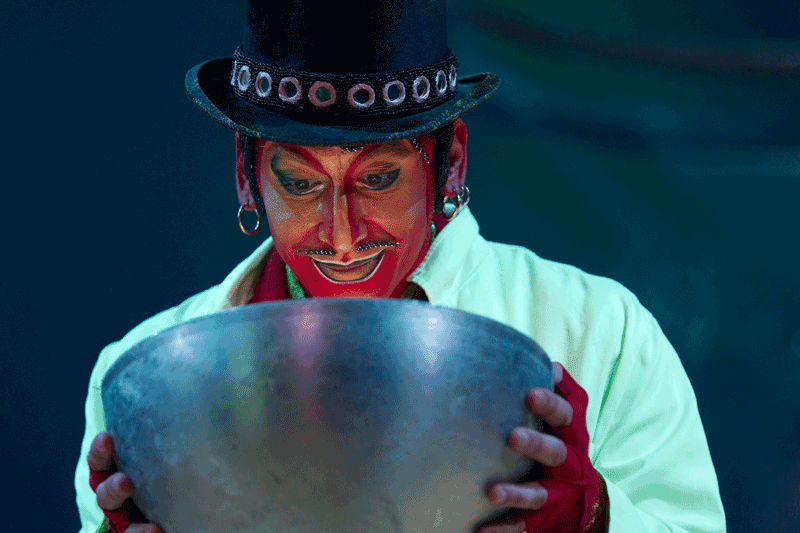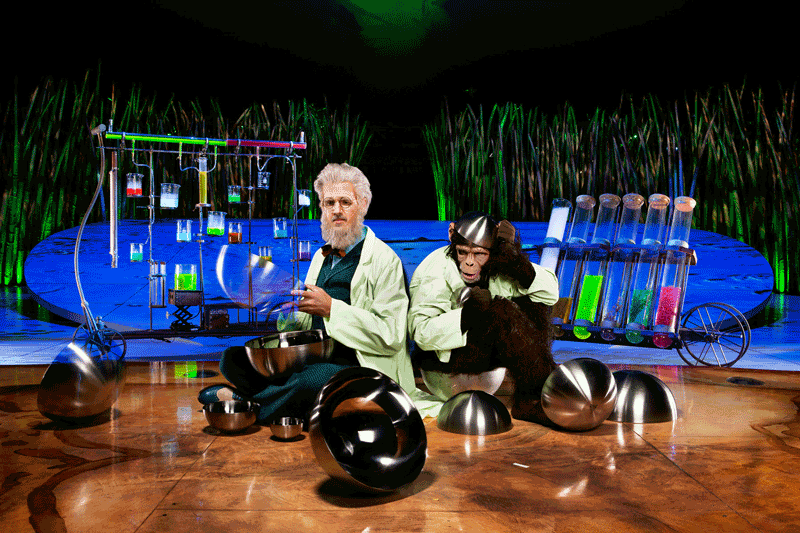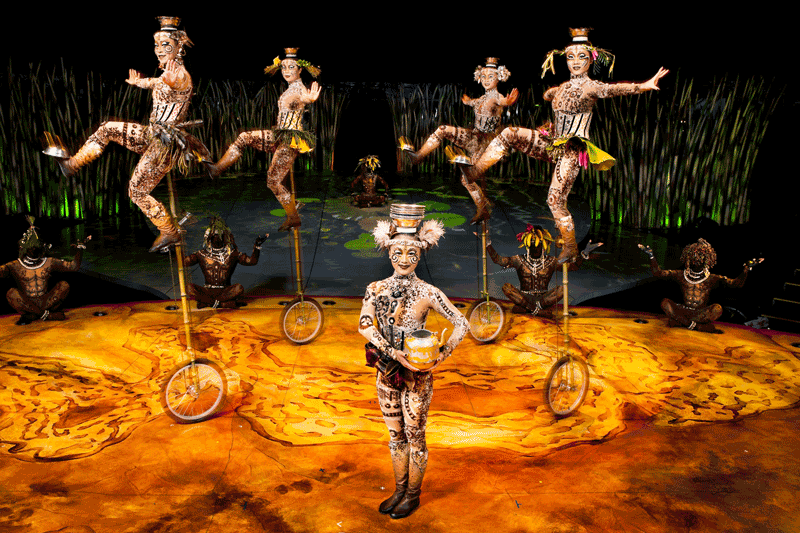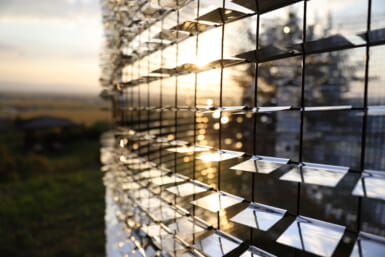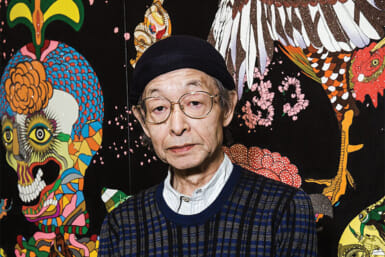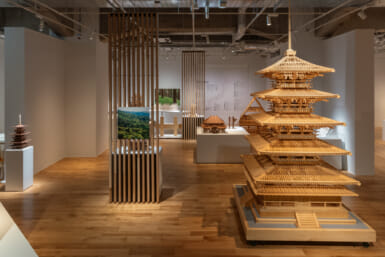“Totem,” the third Cirque du Soleil show to come to Japan, is the company’s most ambitious production yet.
It all starts with The Crystal Man. Glittering and curled up, he drops slowly from the ceiling. The 4,000 mirror pieces that make up his costume sparkle in the spotlight as he dips towards the stage. His commanding presence, hovering over the giant turtle carapace stage set, summons the “frog people” to rise from their slumber, bringing a spark into the show. With a beat of the drums, the fire catches, and life begins.
Cirque du Soleil’s “Totem” has been on tour for the last 6 years, traipsing around the planet to 30 cities in 12 countries, entertaining nearly 4 million. Much of the core cast has remained intact, with just a few performers in rotation. “Totem” is the third Cirque du Soleil show to appear in Japan (“Michael Jackson: The Immortal World Tour” and “Zed” were its predecessors).
This is the second Cirque du Soleil show for creator Robert Lepage. Although it follows his prior “Ka” with its exploration of love and humanity, “Totem” is a stand-alone performance. As coach Umihiko Miya explains, “the creation process of the show took about 8 months,” but the cast and directors continue to evolve the show with every performance and country they travel to. “The music is adapted to please the [country’s] audience culturally,” Lepage explained in an earlier interview. Though there is no set script in the show, one clown character, Valentino, defies the “body language only” rule – and while he babbles away in Italian for the most part, many zingers are in Japanese, inciting giggles from children.
One of the fundamental components of the Cirque du Soleil experience is their hallmark usage of the “Big Top” tents, harking back to days of rustic circuses on the outskirts of French cities. Their trademark yellow and blue tent is taken down and rebuilt in each place it travels to, with stadium seating and earthquake-proof framing. As if by magic, it looks far too small from the outside to hold all that the show entails, including an audience several hundred strong. The audience sits around the stage, atypical of stage performances. Said artistic director Neelanthi Vadivel of the theater layout: “It’s very intimate. The audience is close to the action, so it’s a beautiful experience.” “Totem” follows the evolution of life, from the amphibian stage to a distant future. “[Lepage] really wanted it to jump back and forth through different time periods, different locations on the globe,” explains Vadivel. “We’re trying to tell everybody’s story.”
Each of the dozen acts embodies a particular time and place, and highlights a different kind of performance skill. As the show progresses, each act seems to top the one before, continuing to expand the boundary of human ability, right up to the climax of the two-hour journey through the history of humankind. The breathtaking performances by the cast, including musicians, are all “disciplines you’ve never seen on a Cirque stage before,” proclaims publicist Francis Jalbert.
Technology plays a pivotal role in the production of “Totem.” The stage itself acts as a screen for an overhead video projection for Argentinean volcanoes, Icelandic waterfalls, and American marshes; synchronized performers “dive” into the screen, just as characters “swim” through the screen before crawling out of the stage, a stage that transforms from a turtle shell into a rocket halfway through. The music, lights, and in-air acts all harness high-tech, in what seems to be a nod towards how far we have come, and how much we have evolved, highlighted by the show’s final “cosmonaut” act that launches us towards the future.
The family-friendly show engages audiences even before the lights dim. Clowns and a modern version of a “ringmaster” walk among the audience, throwing popcorn, teasing children with time-honored pocket gimmicks, and snapping photos. Drummers and “apes” make their way into the crowd during the show, keeping the audience on the edge of their seat and getting everyone involved. At times, it’s hard to stay focused on just one character, for fear of missing out on what another is doing.
Many of the show’s pieces were inspired by Lepage’s own upbringing among Native American cultures in Quebec. “The First Nations of the world have a variety of compelling creation myths and stories, as well as a strong connection with nature,” Vadivel elaborates. Those elements were important to the directors and cast. The turtle-shaped centerpiece is acknowledgement of several civilizations’ symbol of origin. Each costume, too, embodies not any single group, but rather, incorporates motifs from several peoples and cultures, from Bollywood to South America. The inclusion plays to the theme that we all come from the same place, and have the same ambition: “to escape Earth’s gravity.” All of the music is inspired by, and includes sound bites from, Native American tribal music, Indian tunes, and Spanish flamenco melodies.
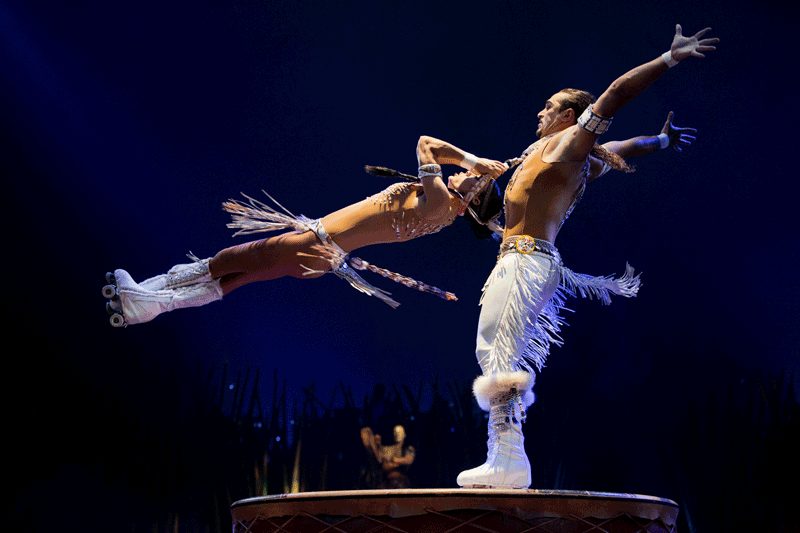
Two roller skaters on a two-meter–wide drum act out a “wedding” in a captivating whirlwind (Photo: OSA Images Costumes: Kym Barrett © 2010 Cirque du Soleil)
Considered to be the most ambitious Cirque du Soleil showcases to date, “Totem” journeys not just through time and lands, but talent. The 40-strong troupe is very much a family—literally. A younger performer, Nikita Moiseev (seen “flying” on the Russian Bars), is the son of Russian Bars coach Alexander Moiseev. Nikita was born while his parents were on tour with Cirque du Soleil’s “Alegria” twenty years ago, and has been in the circus since. “I’ve been performing for 13 years, and I was traveling for most of my life,” says Nikita. Fifty other family members join their partners, parents, and children around the world on tour, keeping in line with the tradition of old-fashioned images of traveling circuses.
Russian Bars performers leap high into the air, flipping multiple times before landing smoothly on 10-centimeter-wide beams. Yet, perhaps the truly mesmerizing acts are the solos or duets: trapeze artists flip and spin high in the air, climbing over each other effortlessly, fearlessly. “The key element for us is to build trust between the porters and flyers – and that takes time,” says Tamir Erdenesaikan, the captain of the Russian Bars team. “We all come from various backgrounds …[and we all] need to adjust to [each other’s] techniques.”
There are other stand-out performers as well. An exhilarating performance by two roller skaters (Massimiliano Medini, and his wife, Denise, who have created their own choreography and performed for 20 years together), plays out a “wedding” on a drum less than two meters wide. The “crystal lady,” who can juggle four spinning rugs on her feet while lying down, the “strong man” who can balance on a single hand, without so much as a tremor, or the exotic hoop dance, executed by Eric Hernandez. He explains that “[It’s] not a circus skill. It is a traditional dance that Native Americans learn from their families and adapt to develop their own styles. Traditionally … it’s a little more static … [we opened it up to the audience and] reworked the dance to make it slightly more theatrical.”
Then there are the “love birds” who can dangle fifty feet in the air, the woman’s head cradled in the hand of the man who is hanging just by his knees – Guilhem Cauchois and Sarah Tessier are the fixed trapeze duo who don yellow and spread their wings high above the audience. “[We] studied for three years at the National Circus School in Montreal … when we joined Totem, we adapted our choreography required for the show,” Cauchois explains. Tessier adds, “[We’ve] performed our act in Totem more than 1,000 times and we know how to readjust …[when] we feel something is wrong or that we don’t catch a trick as planned. We work in symbiosis.” Guilhem concludes, “ I like that our act is impressive acrobatically, but also has the capacity to touch people and speak to them.”
What does it take to stay in shape and train for the show? Performers do anything they can to keep fit, including stretching or weightlifting almost daily. Everyone warm ups for 30 minutes prior to each show, and have one or two full training sessions per week. Each time they move on to the next city, they have three or four days to adjust to the time zone. Luckily, due to this rigorous training, and with close monitoring by coaches, the performers remain at optimal performance levels, reducing any potential close calls with equipment or blocking.
No two performances are alike: “Totem [performers] perceives each of their shows as unique…a truly perfect show is invariably ‘just out of reach,’ as it drives artists to reach further,” explains Vadivel.
“Totem’s” music takes us through the past, the costumes dazzle us with cultural traditions and colors, each act pushes the limits of human flexibility and strength, and the technology flies us into the future: evidence of evolution carries us through the show, right up to the final bow. The narrative and the backbone of “Totem” are the transcendence and importance of love, supporting one another, and continuing to grow – together, as humankind.
“Totem” will be on at Odaiba Big Top until June 26. See totem-jp.com for more details.
Main Image: Photo: OSA Images Costumes: Kym Barrett © 2010 Cirque du Soleil

